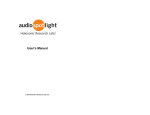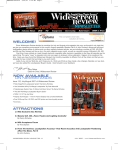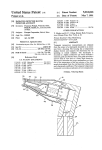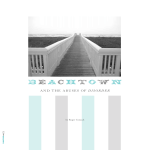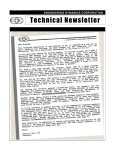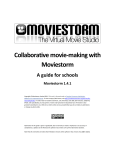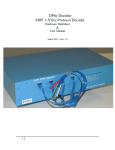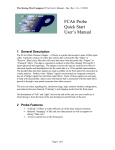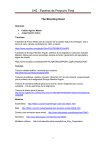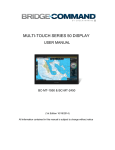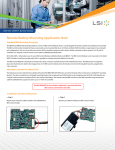Download User`s Manual
Transcript
User’s Manual © 2015 Holosonic Research Labs, Inc. 16,1,2,15,14,3,4,13,12,5,6,11,10,7,8,9 Audio Spotlight® User’s Manual 3 Introduction "... Audio Spotlights may be the most radical technological development in acoustics since the coil loudspeaker was invented in 1925... The audio spotlight will force people to rethink their relationship with sound, as the arrivals of the phonograph, the telephone and the Walkman have done before." - New York Times Thank you very much for choosing the Audio Spotlight system. Years ago as a MIT graduate student, I created the Audio Spotlight because of deficiencies I saw in the way traditional loudspeakers made sound – in particular, their lack of control. Never before has it been possible to give people the power to control not only what their sound is, but also where their sound goes – and as importantly where it doesn’t. I founded Holosonics to commercialize the Audio Spotlight technology, and make it available to anyone who would like to take advantage of its unique features. As we continue to move this unique technology forward, I would like to hear from you regarding your experiences, successes, challenges and ideas regarding the Audio Spotlight technology. I and everyone at Holosonics look forward to working with you. Dr. F. Joseph Pompei President and Founder Audio Spotlight® and Holosonics® are registered trademarks of Holosonic Research Labs, Inc. US and International patents issued and pending. 4 Audio Spotlight® User’s Manual Important Safety Instructions 1) Read these instructions. 2) Keep these instructions. 3) Heed all warnings. 4) Follow all instructions. 5) Do not use this apparatus near water. 6) Clean only with dry cloth. 7) Do not block any ventilation openings. Install in accordance with the manufacturer’s instructions. 8) Do not install near any heat sources such as radiators, heat registers, stoves, or other apparatus (including amplifiers) that produce heat. 9) Do not defeat the safety purpose of the polarized or grounding-type plug. A polarized plug has two blades with one wider than the other. A grounding type plug has two blades and a third grounding prong. The wide blade or the third prong is provided for your safety. If the provided plug does not fit into your outlet, consult an electrician for replacement of the obsolete outlet. 10) Protect the power cord from being walked on or pinched particularly at plugs, convenience receptacles, and the point where they exit from the apparatus. 11) Only use attachments/accessories specified by the manufacturer. 12) Use only with the cart, stand, tripod, bracket, or table specified by the manufacturer, or sold with the apparatus. When a cart is used, use caution when moving the cart/apparatus combination to avoid injury from tip-over. 13) Unplug this apparatus during lightning storms or when unused for long periods of time. 14) Refer all servicing to qualified service personnel. Servicing is required when the apparatus has been damaged in any way, such as power-supply cord or plug is damaged, liquid has been spilled or objects have fallen into the apparatus, the apparatus has been exposed to rain or moisture, does not operate normally, or has been dropped. 15) Installers are required to follow sound and reasonable judgment when installing Audio Spotlight products. Compliance with all building, safety, and fire codes is the sole responsibility of the installer and/or end user. 16) Do not connect Audio Spotlight® devices to traditional loudspeaker amplifiers or loudspeakers. Damage and/or hazardous conditions could result. 17) Our standard cables are not plenum rated. Please contact the factory if special specifications are required. WARNING: To reduce the risk of fire or electric shock, do not expose this apparatus to rain or moisture. WARNING: Terminals marked with the symbol are hazardous live. External wiring connected to these terminals requires installation by a qualified, instructed person or the use of ready-made leads or cords. WARNING: When mounting the speaker panel overhead, always use a secondary fastening method in case the primary attachment fails. The symbol indicates that there are hazardous voltages within the enclosure. Do not open. Refer all servicing needs to the manufacturer, or the manufacturer’s designated service representatives. Audio Spotlight® User’s Manual 5 Package Contents ® Audio Spotlight integrated speaker panel Power Supply, Power cable IR Remote Optional Accessories: Mounting Brackets (see www.holosonics.com) microSD Card System Connections ® Audio Spotlight speaker panel Dual RCA to optional audio source Slot for optional microSD card Power switch To power supply The included power supply will operate with any standard mains voltage and frequency, worldwide. See power supply for detailed voltage and current specifications. 6 Audio Spotlight® User’s Manual System Operation The system can accept audio input from either an external audio source, microSD card, or internal built-in demo tracks. External Audio Source 1. 2. 3. 4. Connect system as shown on the previous page. Press the power switch to power on system. Display will illuminate and show a welcome message. System self-tests, with the bargraph growing from zero to full-scale and back. 5. Ensure that no microSD card is inserted. 6. Start the audio source. 7. Use the ▲(up) and ▼ (down) arrows to adjust volume Using microSD Audio If a microSD card is inserted, the system will automatically loop through all content on the microSD. Any playback through the microSD player will be mixed with the external audio input, if connected. The microSD card must be FAT32 formatted. The built-in player supports standard 16-bit PCM Wave (.wav) or any Ogg Vorbis (.ogg) files. These formats provide higher quality encoding than MP3, and can be encoded and used free of all licensing fees. There are many popular third party programs and online conversion sites available, or you can visit www.holosonics.com/FAQ.html for more information on free file conversion. Holosonics is also happy to assist converting your files directly, if needed. Built-in Demonstration Material Built-in demo material can be accessed by pressing "Mode" until the "Demo" mode is active. Pressing the Up and Down arrows select the specific track to loop, or "All" to loop all of them sequentially. Demonstration Tracks 1. Introduction 2. Birds of a Feather 3. Beachfront Celebration 4. Hungarian Dance 5. Jazz 6. Male Voice 7. Female Voice 8. Birds 9. Glass 10. Laser 11. Footsteps Audio Spotlight® User’s Manual 7 Modes and Settings Change mode with MODE button, and adjust parameters with ▲ and ▼ buttons. In most modes, display will timeout to the default bargraph after a few seconds. All settings are retained after power cycling. Default Mode; bargraph shows output level. Clipping indicated by at the top of the scale. Volume adjustment mode. Up/down alters system volume from 0-99 (max) Clipping indicated by . Sets built-in audio processing preset A,B,C Preset A: Optimized for typical full-frequency content Preset B: Optimized for raw voice Preset C: Optimized for maximum output Demo Mode (off by default) Standard demo track loops Loops all demo tracks Input level monitor bargraph. Input level is clipping; source level is too high Input level is too low for optimal performance Low frequency EQ control (Bass) -9 to +9 High frequency EQ control (Treble) -9 to +9 Autolevel Off/On. Applies a compressor algorithm to adjust volume automatically for best results. Boost Off/On. Applies a soft clip limiter that introduces light THD in exchange for additional perceived output level. IR active mode Off/On. Use to disable IR control. Factory reset all settings, press up arrow to reset To confirm factory reset, press up arrow again Audio Spotlight® User’s Manual 8 Speaker Mounting The speaker panel was designed for flexible mounting. Two M6 holes in the center are compatible with most loudspeaker brackets, and four M4 holes in a VESA100 pattern are compatible with a wide variety of additional brackets. Two keyhole mounts allow mounting flat against most surfaces. 3.94" 100 mm 4 x M4 (VESA100) 2 x M6 2 3/8" 60.3 mm Keyholes for M6 or 1/4-20 panhead NOTE: When using the keyhole mounts for overhead mounting, a secondary fastener, bumper, or retainer MUST be used in case the speaker is inadvertently moved, to prevent falling. Wall / Ceiling Holosonics recommends using our own mounting kits (MNT-1) with ® Audio Spotlight speakers. The bracket attaches to the back of the speaker with two included screws, and can mount to any suitable flat surface. By loosening the screw on the bracket, the speaker panel can be aimed as desired. An extension arm is also included. See the instructions that come with the MNT-1 kit for more details. Audio Spotlight® User’s Manual 9 Overhead cable hanging Overhead cable hanging is useful when shining the Audio Spotlight beam straight down, particularly from a high ceiling. Use four M4 eyebolts to suspend the speaker panel from steel cable. Eyebolts are commonly available, and Holosonics can supply them upon request. Suspended Ceilings Suspended ceilings are not designed to support all loads. When hanging any object from a suspended ceiling, be sure that it is connected to the structural ceiling and is rigid enough to support the speaker panel. Flat mounting: The thin profile of the Audio Spotlight speakers makes mounting flat against a ceiling attractive and simple. Our CM-1 mount kit contains a support brace for using inside the ceiling grid, and two long screws for attaching the speaker. Aiming: Our CM-1 kit is compatible with the MNT-1 mount, allowing flexible aiming of the speaker panel in a suspended ceiling. The MNT-1 attaches to the ceiling panel with two long screws, two washers, and two nuts. The screws extend up to the support brace and connect with two more nuts. Ceiling tile replacement: The AS-24i model is designed to precisely replace a standard 2’x2’ or 600mm ceiling tile. This allows for seamless integration in suspended ceiling applications. Be sure that the ceiling frame is sufficiently strong to safely support the weight of the speaker panel, and always use a backup line for safety. Audio Spotlight® User’s Manual 10 Understanding the sound field The Audio Spotlight directional speaker creates a very precise, wellcontrolled beam of sound with no sidelobes or other artifacts typical of traditional loudspeakers. Because sound is created in mid-air, and not by the speaker panel, sound actually gets louder with distance – up to about 1 or 2m, depending on frequency. Sound also diminishes with distance much more slowly than a traditional loudspeaker, creating a more uniform field of sound. An illustration of the field from the AS-16i system is shown below. Three contours are shown, at the contours of –0dB, -6dB (50%), and – 20dB (10%). Additional data is shown in Appendix A. 0m 1m 2m The loudest sound area is directly in front of the speaker panel at a distance of 1-2m. Sound levels outside the beam are reduced by over 90%. In all sound systems, audibility is determined by sound level received versus background noise levels. Therefore, the beam will be perceived as more narrow in the presence of background noise, as any scatter from a listener or floor will be inaudible. This is much like the difference in shining a flashlight in a completely dark room versus one with background lighting. Audio Spotlight® User’s Manual 11 Basic Installation The most common use of the Audio Spotlight technology is to deliver sound to a specific, isolated area. Just as with lighting, the Audio Spotlight speaker is best mounted directly above the listener, aimed downward (left). This provides maximum localization. The speaker panel can also be mounted on a wall, and angled downward, to reach the listener (right). Reflections While the beam generated by the Audio Spotlight system is very narrow, the beam will reflect from surfaces (and listeners) in your environment, just like light. To sound waves, solid surfaces are much like mirrors are to light. Therefore, to reduce reflections, an acoustically absorbing surface (such as carpet, padding, or curtains) could be used to ‘catch’ the beam and reduce the reflection. Generally, this is useful only in very quiet spaces, where there is little background noise to mask minor scattered energy. Also, like light, reflections can be used as projection of audible sound. By directing the beam against a surface, one can create very interesting “virtual loudspeaker” effects. The beam will generally maintain its directivity after projection, so it is best to ensure that the listener is in the path of the reflected beam. 12 Audio Spotlight® User’s Manual Multiple systems Multiple Audio Spotlight systems can be used to create a larger field of sound, or to increase the sound intensity in a given region. Just like visual spotlights, beams of sound can be aimed next to each other, to “shape” the sound field (left), or multiple speaker panels can be aimed to one position (right). Just as with light, sound from these systems will combine to increase output substantially. This can be done over very long distances to create long-throw beams of sound. Many variations of these basic designs are possible – this manual is intended to act as a guide. In considering different ways to install the Audio Spotlight speakers, keep the lighting analogy in mind. More often than not, Audio Spotlight should be thought of in lighting design terms, not in loudspeaker terms. As always, Holosonics is happy to assist with your project. Audio Spotlight® User’s Manual 13 Subwoofer Augmentation While a traditional subwoofer is, of course, not directional, it can nonetheless be used effectively to augment the low-frequency reproduction of the Audio Spotlight system. The human ear, and a listener’s attention, is most sensitive to frequencies between 600Hz and 2kHz. As long as the level of the subwoofer is not too loud, and is limited to reproducing only low frequencies, the slight rumble that exists outside of the Audio Spotlight beam is generally unnoticed. Connecting a subwoofer is straightforward. Use a standard splitter (or “Y”) cable to send the same line-level signal to the Audio Spotlight and subwoofer systems. Since this line level is not amplified, a powered subwoofer, or separate amplifier, is required. The subwoofer’s crossover frequency, if it is adjustable, should be selected to suit your listening material and background noise. For isolated bass reproduction, one may also use a tactile transducer, such as the Aura Bass Shaker or Clark models. Contact Holosonics if you need assistance or subwoofer recommendations. Audio Spotlight® User’s Manual 14 Appendix A: Sound Field Specifications Design Specifications: AS-168i AS-16i AS-24i In general, there is a doubling of available output power and an additional octave of low frequency reach stepping up from the smallest AS-168i model to the AS-16i, and once more from the AS-16i to the larger AS-24i. Sound fields shown for standard 1kHz tone. Audio Spotlight® User’s Manual 15 Limited Warranty Holosonics warrants that your Audio Spotlight system is free from defects in material and workmanship for a period of one (1) year after date of purchase. This warranty does not cover claims for damage caused by accident, misuse, neglect, alteration, outdoor use, disassembly, unauthorized repair, shipping, or modification. Holosonics’ liability is limited to the repair or replacement, at our option, of any defective product, and shall not include incidental or consequential damages of any kind. Warranty is void if serial number is defaced or removed. Service If your Audio Spotlight system needs service, please contact Holosonics for a return materials authorization (RMA) number. Received units will not be accepted without a valid RMA. Call us, or email [email protected]. NO USER SERVICABLE PARTS ARE INSIDE THE SYSTEM. DO NOT OPEN. Holosonic Research Labs, Inc. 400 Pleasant Street Watertown, MA 02472 USA Phone: Fax: Email: Web: 617-923-4000 617-507-3474 [email protected] www.holosonics.com © 2015 Holosonic Research Labs, Inc. (“Holosonics”) Audio Spotlight® and Holosonic® are registered trademarks of Holosonics. US and International Patents Apply v12c Birds of a Feather excerpt written and recorded by The Rosenbergs, Copyright 2004. Used with permission. Beachfront Celebration excerpt written and recorded by Kevin MacLeod (incompetech.com). Licensed under Creative Commons: By Attribution 3.0 http://creativecommons.org/licenses/by/3.0/
















